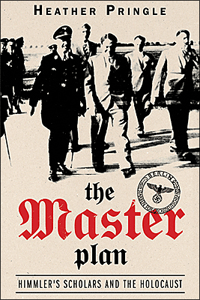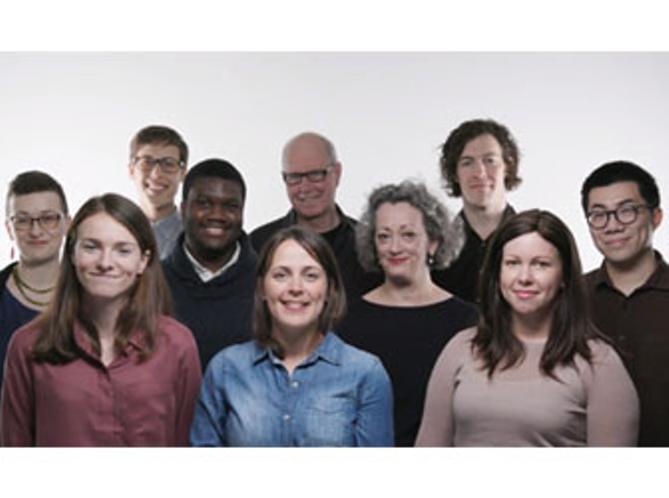
- The Master Plan
- Viking Canada (2005)
- Bookstore Finder
Vancouver writer Heather Pringle's powerful new book, The Master Plan: Himmler's Scholars and the Holocaust, tells the story of a very bad idea whose time had come. The bad idea was that there is a superior race of people, the blond-haired, blue-eyed, tall and muscular Aryans, whose alleged descendants are destined to rule the world. The time for bad ideas that had come was 1933-1945, the era of Nazi Germany.
The man who gave practical and institutional form to the idea of a "master race" was a distinctly non-Aryan-looking, bookish Bavarian, then in his mid-30s, named Heinrich Himmler. He was, as Pringle reports, "head of the Gestapo, the Security Service and the Security Squad or SS, a paramilitary organization that ran Germany's concentration camps, controlled a profitable network of business enterprises and provided Hitler's personal bodyguard." He was, next to Hitler, the second most powerful figure in the Nazi hierarchy. Yet, for all his murderous busyness, Himmler was, Pringle adds, "something of a bookworm," a man of ideas, with genuine if bizarre intellectual interests.
To give concrete shape to his ideas, in 1935 Himmler founded an elite Nazi research institution called the Ahnenerbe. This rather obscure German word, "Ahnenerbe" (pronounced AH-nen-AIR-buh), refers to "something inherited from the forefathers," or simply, ancestral heritage. At the height of its activities, in 1939, it was headquartered in a posh villa in Berlin's wealthy Dahlem district, and employed some 200 scholars, scientists and support workers.
The research institute's main job was to come up with new evidence for the existence and triumphs of Germany's purported ancestors, going as far back as the Paleolithic or Old Stone Age. Once the scholars had established the reality of the mythical Aryans, Himmler had the notion that the "master race" could be further purified and perpetuated by establishing utopian agricultural communities stocked with carefully chosen SS families. It was a dream of ethnic cleansing with a vengeance.
The Nazi Joneses
To those ends, Ahnenerbe archaeologists, anthropologists, "racial experts" and sundry other scientists planned and carried out a series of wide-ranging expeditions, including field trips to Sweden to study Nordic rune-"writing," archaeological digs in the Crimea and an Indiana Jones-style journey to remote Tibet in search of clues to the imaginary Aryan past. It pumped out a sizeable pile of "findings," which were conveyed to both the future SS leadership ranks and the German public in a stream of popular magazine pieces, books, museum installations and scholarly conferences.
"In reality, however," Pringle persuasively argues, "the elite organization was in the business of myth-making. Its prominent researchers devoted themselves to distorting the truth and churning out carefully tailored evidence to support the racial ideas of Adolf Hitler. Some scholars twisted their findings consciously, others warped them without thought...but all proved adept at this manipulation and for this reason, Himmler prized the institute." Pringle's popularly written, solidly documented account of an obscure and chilling corner of scientific and political history is not only an absorbing read, it also answers the question "What happens when science falls prey to a deadly political agenda?"
Two aspects of The Master Plan make this book quite a bit more than just another small-but-interesting addition to the groaning shelf of Nazi history. First, Pringle's quest through the labyrinthine and often charred remains of history is an extraordinary intellectual detective story. Second, as well as adding to the store of our historical understanding of totalitarianism, her account is a real contribution to both the history of ideas (in this case, bad ones), and the political sociology of how idea systems are developed and integrated in particular societies.
Pringle's curiosity about Himmler's "calculating use of the past" was first tweaked while researching an earlier book, The Mummy Congress, when she was in the Netherlands, looking at 2,000-year-old Roman-era corpses that had been preserved in Europe's northern peat bogs. Pringle, as quickly becomes obvious, has a diviner's instinct for odd corners of science and history. Among the documents about the peat bog mummies, Pringle ran into a 1937 speech given by Himmler in which he claimed that the often violent deaths observed in the peat bog remains could be explained by the hypothesis that the victims were homosexuals and other social pariahs who had been executed for their transgressions against ancient Germanic laws. Pringle tucked this oddball bit of homophobic speculation away in a file.
The scientists history forgot
When she began her Ahnenerbe project in 2001, Pringle expected to find a lot already written on the subject. To her surprise, there was nothing in English, and only one significant work in German, a book written, curiously enough, by a Canadian historian, Michael Kater, in the mid-1970s. While it might have been expected that Kater's pioneering work would spark further research, Pringle learned that most German scholars tended to dismiss the Nazi-era pre-historians as "harmless fellow travellers," or worse, were reluctant to look into the backgrounds of scholars who had since gone on to often-prominent positions in German academia.
It wasn't until after the fall of the Berlin Wall in 1989 that it was possible for a prominent East German archaeology professor, Achim Leube, to pursue a long-standing interest in Nazi archaeology. It was Leube who in 1998 organized the first international conference on the subject that brought together researchers from a dozen countries and attracted the attention of writers like Pringle. Since beginning her research, one additional book has appeared in English, Christopher Hale's Himmler's Crusade (2003), but its focus is on the Tibet expedition, whereas Pringle presents the broader and more complete picture.
Her account of discovering the truth about the Ahnenerbe think-tank is an engaging tale in its own right, one that doesn't conclude until the end of Pringle's book, when in a small German town, she tracks down a 91-year-old former Ahnenerbe racial researcher, still surrounded by souvenirs of his Tibetan expedition in the 1930s, and conducts an interview that is, by turns, both bland and chilling in its demonstration of the "banality of evil," as the philosopher Hannah Arendt famously called it.
The other fascinating feature of Pringle's tale, as she traces the origin of the Aryan idea back to the then-novel field of linguistic studies in the late-1700s, is the recognition of the tempting plausibility of bad ideas, as well as good ones. Of course, today we're critical even of the notion of "race," which scientists have tended to drop in favour of research into ubiquitous DNA and genetic material found throughout the human species, irrespective of differences in facial and bodily "types." We also know that there's no evidence of some ancient superior people destined to rule the world, and that the tribal groups in Asia associated with the term "Aryan" have no discernible connection to mid-20th century Germanic populations.
What we didn't know did hurt
But we didn't know a lot of that as recently as 1933, the year of Hitler's ascension to power. The grain of truth, which quickly became a grain of half-truth, in Nazi racial theories could be traced to an 18th century British naturalist, James Parsons. In trying to figure out the origins and dispersal of the various peoples on earth from faint clues in the Bible, Parsons came up with a powerful tool, comparative linguistics, by which he located some striking similarities between major European and Asian languages. It was the discovery of a family of "Indo-European" languages that provided one of the many seeds for Nazi racial ideology. Once the linguistic sources of global relationships were mixed with the Romantic lust for a past and future golden age, you had the makings of a lethal 1000-year Reich ideological brew.
In the course of sorting out various multidisciplinary ideas and projects, Pringle briskly and intelligently tracks the work of the Nazi think-tank through roughly three phases of activity, and turns up an intriguing and sometimes repulsive cast of characters along the way. In the pre-war phase, Ahnenerbe scholars trekked far and wide, seeking clues by which to construct an Aryan past. On the side, they also did a bit of intelligence gathering for future use in the coming war. The institute's most intrepid researcher, Ernst Schaefer, led the 1938 expedition to Tibet, perhaps the high point of the Ahnenerbe's activities. Plans for even more far-flung ventures had to be put on hold once Germany invaded Poland in September 1939.
The Ahnenerbe, in its next phase, was quickly turned into a gang of looters, responsible for cataloguing, packing up and shipping to German vaults, the pre-history treasures of Poland, while a similar gang of art thieves under Herman Goering went after the art masterpieces. There was the predictable amount of private pilfering in the midst of the art theft chaos.
In its final phase, during the course of and right down to the end of World War II, even as the defeat of the Nazis loomed, the institute was still grimly engaged in trying to "scientifically" figure out how to accurately identify various Jewish populations, a problem compounded by the stubborn fact that a consistent percentage of Jews, perhaps 10 per cent or so, had blue eyes, blond hair, and all the other features of the imaginary master race.
Ahnenerbe physical anthropologists and racial experts who had applied their calipers to measure the heads of Tibetans a few years earlier, were now working in the concentration camps on something called the Jewish Skeleton Collection, a project whose name itself tells us perhaps as much as we want to know. This is the stomach-churning, gruesome part of Pringle's research, and reminds us once more of the monstrous ideas at the core of the Holocaust genocide. Pringle handles the vast array of multidisciplinary information, chunks of intellectual history and the drudgery of detailing the day-to-day operations of scholarly bureaucracy with economy and intelligence throughout her book.
The many cults of ignorance
At the end, Pringle searches out the fates of the Nazi pre-historians after World War II and comes up with a final surprise. Although Himmler crunched a cyanide capsule after his capture by the Allies, and the institute's managing director, Wolfram Sievers, was executed as a result of the Nuremberg war crimes trials, most of the Ahnenerbe scientists went on to successful post-Nazi careers in academia and elsewhere, and peacefully died in their beds at ripe old ages, often with few regrets about their pasts.
While the work of the Ahnenerbe retrospectively looks like a mishmash of half-baked ideas and shaky leaps of logic, in the context of a resurgent Germany under the Nazis, its crankiest notions were plausible and enticing. I think most readers of Pringle's Master Plan will be struck by its contemporary relevance. What ideas are afloat today, we have to ask, that could easily give rise to living nightmares as terrifying as those of more than a half-century ago?
In our supposedly more sophisticated times, we have everything from Christian and Islamic fundamentalisms, with their apocalyptic visions of the end of our world, to New Age fringe cults, to say nothing of a paranormal panoply of alien abductions, psychic powers and alternative medicine. The latter, by the way, was a subject that also interested the Nazis, given that they distrusted mainstream medical theory because it was, after all, "Jewish medicine." What bad ideas of our own are waiting in the wings for the right moment to step onto the world stage?
Stan Persky teaches philosophy at Capilano College in North Vancouver, B.C., and is the author of The Short Version: An ABC Book, which won the 2006 Hubert Evans Prize for Non-Fiction. ![]()




